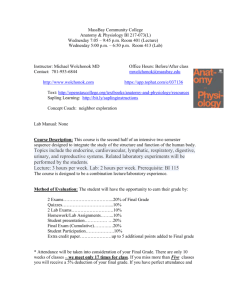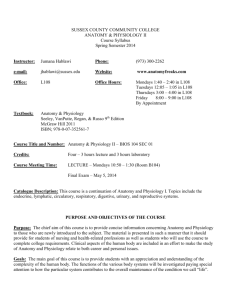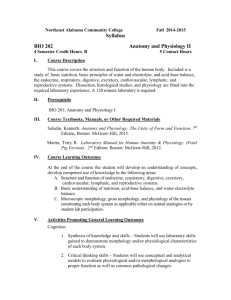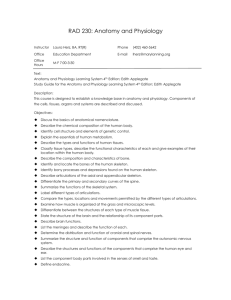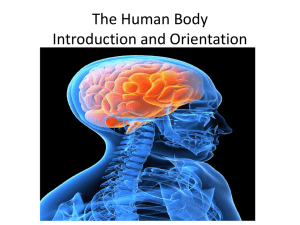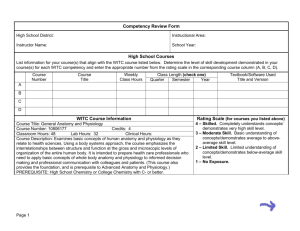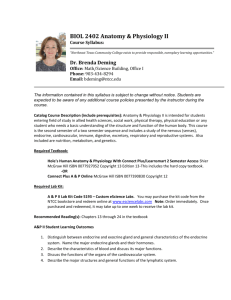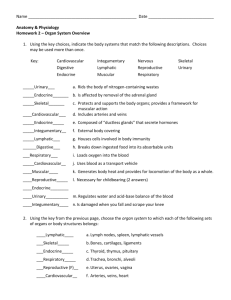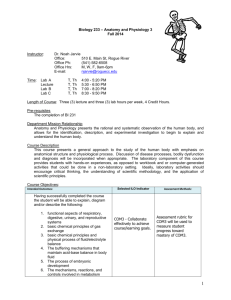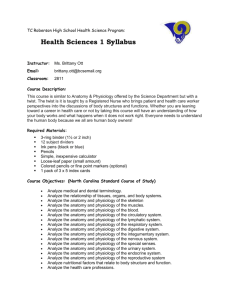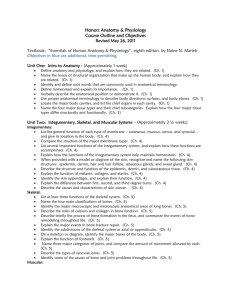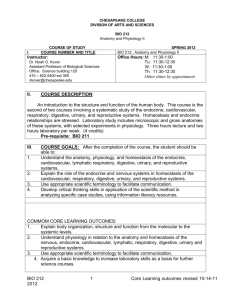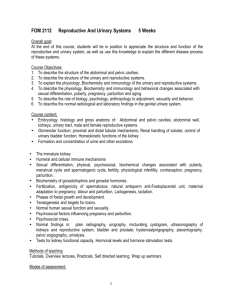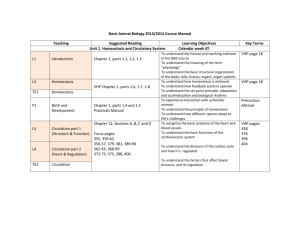A&P new course Grid - Pakistan Nursing Council
advertisement
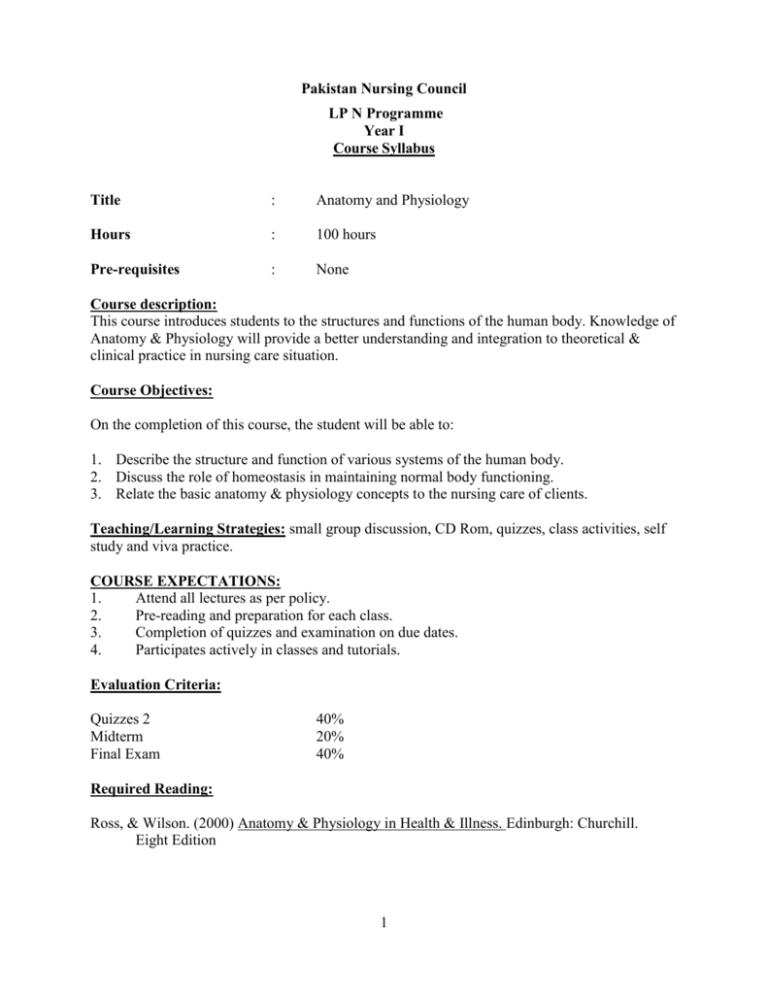
Pakistan Nursing Council LP N Programme Year I Course Syllabus Title : Anatomy and Physiology Hours : 100 hours Pre-requisites : None Course description: This course introduces students to the structures and functions of the human body. Knowledge of Anatomy & Physiology will provide a better understanding and integration to theoretical & clinical practice in nursing care situation. Course Objectives: On the completion of this course, the student will be able to: 1. Describe the structure and function of various systems of the human body. 2. Discuss the role of homeostasis in maintaining normal body functioning. 3. Relate the basic anatomy & physiology concepts to the nursing care of clients. Teaching/Learning Strategies: small group discussion, CD Rom, quizzes, class activities, self study and viva practice. COURSE EXPECTATIONS: 1. Attend all lectures as per policy. 2. Pre-reading and preparation for each class. 3. Completion of quizzes and examination on due dates. 4. Participates actively in classes and tutorials. Evaluation Criteria: Quizzes 2 Midterm Final Exam 40% 20% 40% Required Reading: Ross, & Wilson. (2000) Anatomy & Physiology in Health & Illness. Edinburgh: Churchill. Eight Edition 1 UNIT OBJECTIVES: Unit I INTRODUCTION TO THE BODY AS A WHOLE: At the completion of this unit, students will be able to: 1. Define the term A&P 2. Understand the relationship between A&P 3. Define level of organization of the body 4. Define anatomical position 5. Describe the various body planes 6. Define the body cavities 7. Discuss body cavities and list the organs lying within each cavity 8. Identify abdominal pelvic region & quadrant 9. Identify the organs present in Nine (9) abdomino pelvic regions. 10. Briefly discuss the importance of abdomino pelvic quadrants and regions Unit II HOMEOSTASIS & ADAPTATION: At the completion of this unit, student will be able to: 1. Define the term homeostasis 2. Discuss the factors which effect homeostasis 3. Define feedback mechanism and its components. Unit III CELL, TISSUES & MEMBRANES: At the completion of this unit, student will be able to: 1. Describe the structure and functions of a cell 2. Discuss the process of cell division i.e. mitosis and meiosis. 3. Classify the tissues of the body on the basis of structure, location and function into the following four major types. Epithelial tissue Connective tissue Muscle tissue Nervous tissue Unit IV THE SKELETAL SYSTEM: At the completion of this unit, student will be able to: 1. 2. 3. 4. 5. Define skeletal system Discuss the structure, types and functions of bone List the functions of the skeletal system Identify the bones of axial & appendicular skeleton Describe the various markings on the surface of bones 2 Unit V THE JOINTS: At the completion of this unit, student will be able to: 1. Define the term joint. 2. Describe three types of joints I.e. Fibrous Cartilaginous Synovial 3. Describe the common characteristic features of a synovial joint. Unit VI THE MUSCULAR SYSTEM: At the completion of this unit, students will be able to: 1. Define Muscle and list the types of Muscles. 2. Describe the location and function of major muscles of: The neck The face The back The arms The legs Unit VII INTEGUMENTARY SYSTEM (SKIN, NAIL & HAIR): At the completion of this unit, student will be able to: 1. Describe the structure of two layers of skin Epidermis Dermis 2. Briefly discuss the structure & function of skin derivatives. Sweat gland Sebaceous gland Hair Nail 3. Briefly discuss the following functions of skin Protection Regulation of body temperature Sensation Absorption Excretion Unit VIII THE CARDIOVASCULAR SYSTEM: At the completion of this unit, student will be able to: 1. Define blood and list its functions 2. Describe the composition, and functions of cellular parts of blood and plasma. 3. Briefly explain the ABO blood groups & Rh factor. 3 4. Describe the location, structure and functions of the heart and its great blood vessels. 5. Explain the structure and function of: Arteries Veins & Capillaries 6. Describe the following types of blood circulation: Pulmonary circulation Systemic circulation (coronary & hepatic portal circulation). Unit IX THE LYMPHATIC SYSTEM: At the completion of this unit, student will be able to: 1. 2. 3. 4. 5. Define lymph & the lymphatic system Identify the organs of lymphatic system Describe the general functions of the lymphatic system Describe how lymph is formed Describe the lymph vessels & how lymph is returned to the blood vessels Unit X THE DIGESTIVE SYSTEM: At the completion of this unit, students will be able to: 1. 2. 3. 4. 5. define the digestive system and list its functions Identify the various organs of digestive system Describe the anatomy & physiology of digestive organs Discuss the role of accessory organs in digestion Discuss digestion of food 6. Discuss the absorption of nutrients in the digestive system 7. Discuss the process of defecation Unit XI URINARY SYSTEM: At the end of this unit learners will be able to: 1. 2. 3. 4. Define the Urinary System List the organs of Urinary system Discuss kidneys in terms of external anatomy, Location & gross structure Discuss the structure and functions of Ureters, Urinary bladder, Urethra Unit XII NERVOUS SYSTEM: At the end of this unit learners will be able to: 1. 2. 3. 4. 5. Define Nervous system Briefly discuss organization of Nervous system Describe the structure and function of Neuron Define nerve & its types Identify the principle parts of the brain with their functions 4 Unit XIII SPECIAL SENSES: At the end of this unit learners will be able to: 1. 2. 3. 4. Describe the structure and function of Ear Describe the physiology of hearing and Balance. Describe the structure and function of Eye. Describe the physiology of sense of sight Unit XIV ENDOCRINE SYSTEM: At the end of this unit learners will be able to: 1. Define Endocrine system 2. Identify Endocrine glands present in the body 3. Briefly discuss the hormones& their functions of endocrine glands Unit XV REPRODUCTIVE SYSTEM At the end of this unit learners will be able to: 1. Define Reproduction 2. Define Reproductive System. 3. List the structure &functions of male & female reproductive system Unit XVI Respiratory System At the end of this unit learners will be able to: 1. Define respiration 2. Define respiratory system 3. Discuss the structure & function of all respiratory organs 4. Discuss the mechanism of breathing 5. Explain the type of respiration 5 COURSE SCHEDULE Date/Time Topic Introduction of the Course. Unit I: Introduction to Anatomy & Physiology Body planes & cavities Unit II: Homeostasis and Adaptation Unit III: Cell, Tissue & Membrane Tissues & Membrane Unit IV: The Skeletal System Axial Skeleton Appendicle Skeleton Unit V: The Joints Unit VI: The Muscular System Unit VII: The Integumentary System Nail & Hair Unit VIII: The cardiovascular system: Unit IX The lymphatic system: Unit X The digestive system: Unit XI: Urinary system Unit XII: Nervous System Unit XIII: Special Senses Unit XIV: Endocrine System Unit XV: Reproductive system Unit XVI: Respiratory System 6 Faculty

